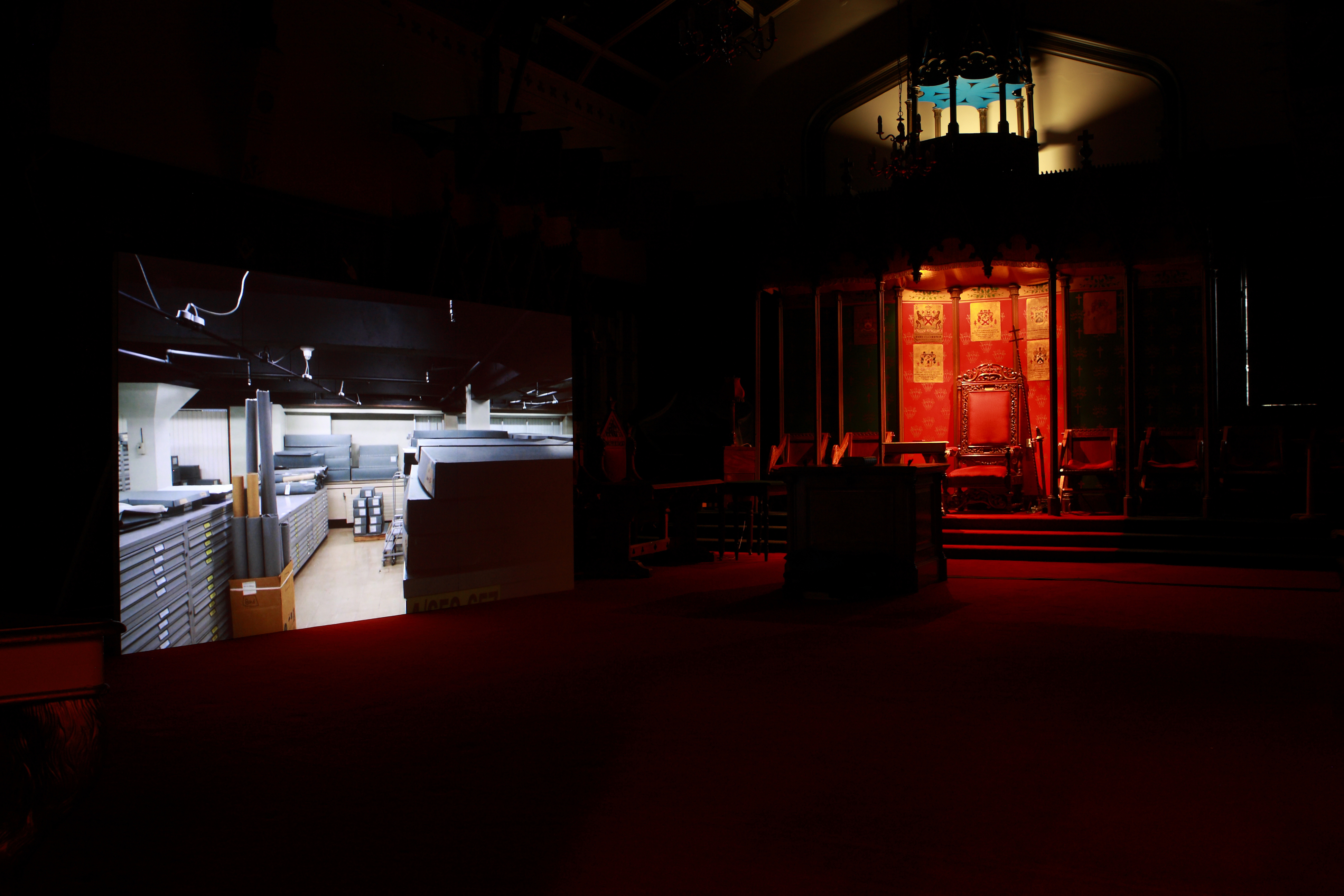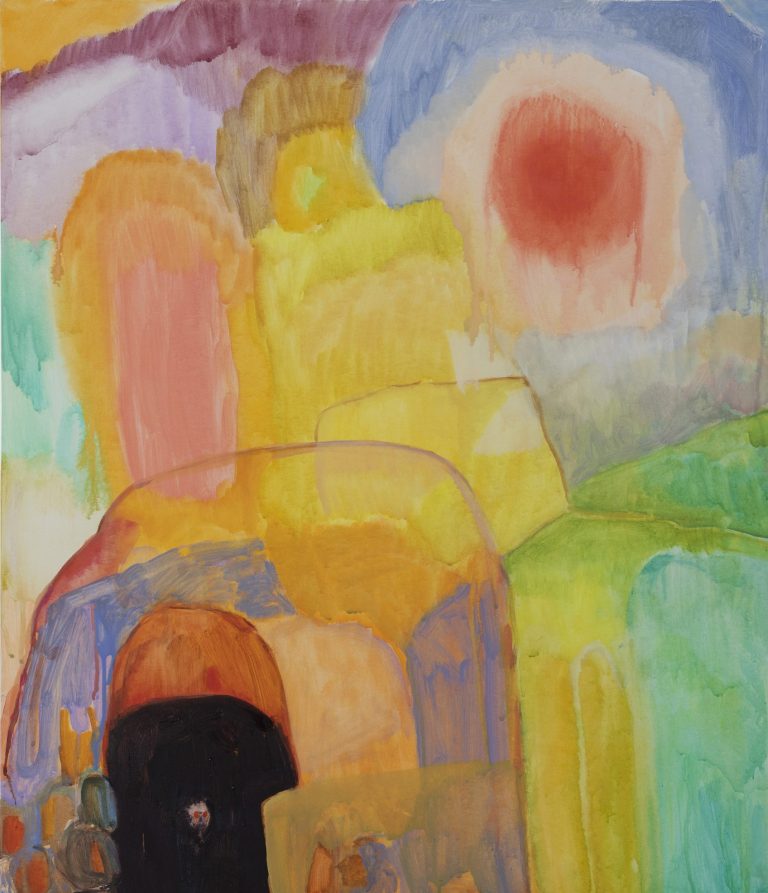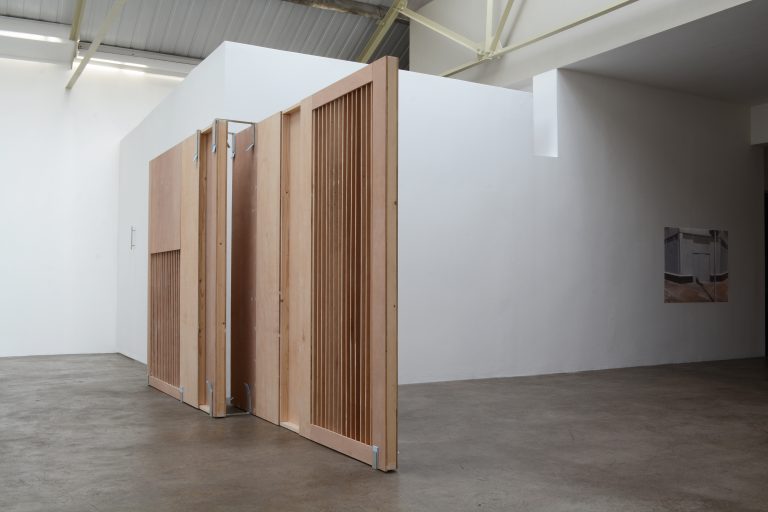A yellow rose was a recent exhibition by Colin Martin, Owen Boss, and Tom O’Dea in The Freemasons’ Hall on Molesworth Street – possibly one of the most charged and uncanny buildings in the city centre of Dublin. For Boss, Martin, and O’Dea, college friends who graduated from MFA in NCAD in 2010, the point of departure for the exhibition was their shared interest in ‘the complex relationship between art and reality’.[1] They used a short story by Jorge Luis Borges titled “A Yellow Rose” as a backdrop for their investigation into the ‘futility of art as a means of conveying reality’, a sentiment echoed by the unusual setting chosen for the show – itself a place which struggles with the burden of representation, of rituals, public image, and perception.
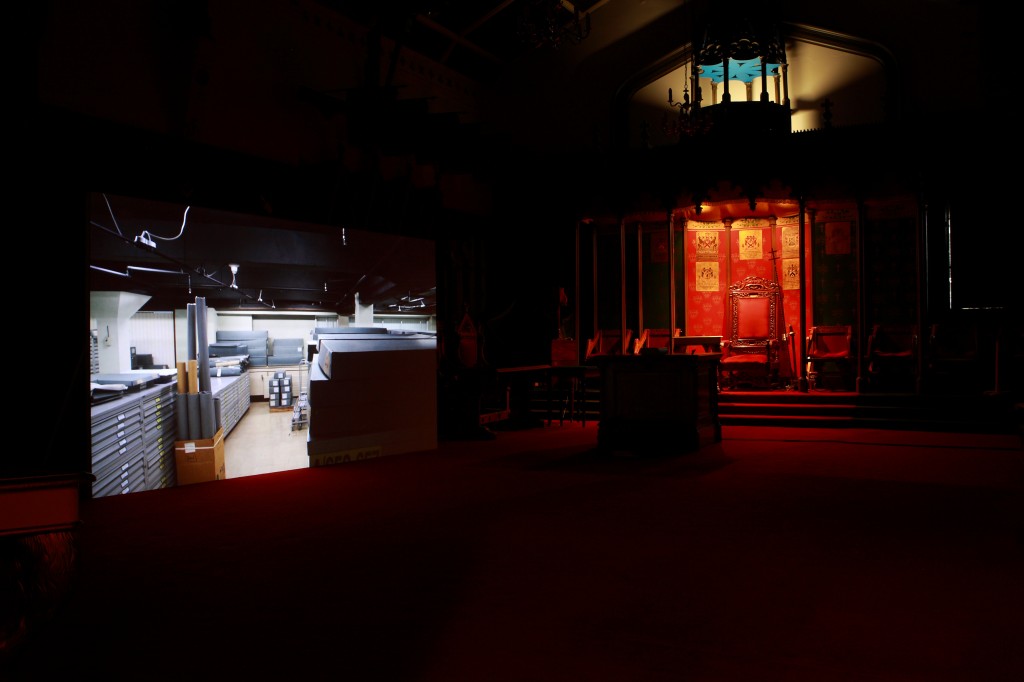
Colin Martin: Basic Spaces, 2012
HD video, installation view
Image courtesy the artist.
A yellow rose created an extraordinary opportunity to navigate through the ritualised spaces of the Freemasons’ Hall and to become familiar with this terra incognita via a negotiation of the artworks. From the outset, the audience was put in the position of an inquisitor: you had to look daringly and inquisitively around in order to notice and acknowledge the artworks, to differentiate between the intentional and the incidental.
The latter was particularly relevant in reference to the Post-Minimal aesthetics of Tom O’Dea’s work which quietly occupied the ground floor. Finding it required a deliberate effort. Guided to the library as the first stop by the map provided, O’Dea’s small abstract drawings made with permanent marker on paper were found behind the glass doors of the bookshelves, leaning against the sedate rows of aged book spines. The drawings, often coupled together, formed unlikely and delicate geometrical shapes which were unassuming and seductive in their fragility. Non-representational, from a distance they seemed to serve a practical purpose, as if a bookmark or a post-it were left behind to draw our attention to a particular volume. Further to the right, two small artefacts rested among the books. Resembling minerals or desert fossils, they both looked quite antiquated and weather-beaten, as if left exposed to the elements for centuries. O’Dea’s work subtly questioned what belonged in the space. Some objects quietly mimicked the architectural features of the building, its skewed corners or bulky carvings, others challenged its ritualistic denomination. On my way up to the second floor, I nearly missed a small piece of drafting tape which glistened among the cracks in the wall only a shade darker than the paint (O’Dea’s Waning and Remaining).

Tom O’Dea: Bay, 2012
lino, wax paper, 200 x 80 x 10mm
Image courtesy the artist.
The reference of the latter piece to the temporal and the cyclical, set an ideal foundation for the encounter with Colin Martin’s Basic Spaces – a single channel video depicting seven different sites: from a mundane office space, a garbage dump, to the studio of the artist Michael Warren. Often devoid of natural light, the sites depicted seem to be suspended in time and at first sight, are strange and unfamiliar. It is the furniture, and decorative and architectural aspects of the spaces, that expose the nature of their use. This work reflects the Martin’s ongoing investigation into what Robert Venturi called the “decorated shed as a conduit for social, cultural and political value.” The fact that the work was projected in the Prince Masons’ Chapter Room further compounded the conceptual tension as Martin’s ideological inquest into idealised spaces collided with the ornate and charged surroundings.
Yet what really makes Martin’s work exceptional is his sensitivity and patience for the objects with which he chooses to engage. In both Basic Spaces and Vitrine the HD camera lens travels at a steady speed, always from left to right giving the audience a full panorama of what is on view. By default the camera picks up the most prominent colours, the piercing blues and reds, infusing it with a dream-like quality. The emerging images look as if they were ‘frozen in a moment’ and it is that momentary suspension that fixes our gaze and allows for a more intimate engagement. In Vitrine – a two-channel cinematic study of a defunct exhibition hall in the National History Museum during its refurbishment – the steady camera pace creates an illusion of looking at a painting. However, by projecting the video onto both sides of a rectangular tank which sat upon a plinth, this visual experience expanded three-dimensionally from within the screen out beyond it. This reflection of space was enhanced by the immediate surroundings: replicas of Egyptian sphinxes, ancient artefacts, and religious paraphernalia which prompt strange confusion and overlap of realities.
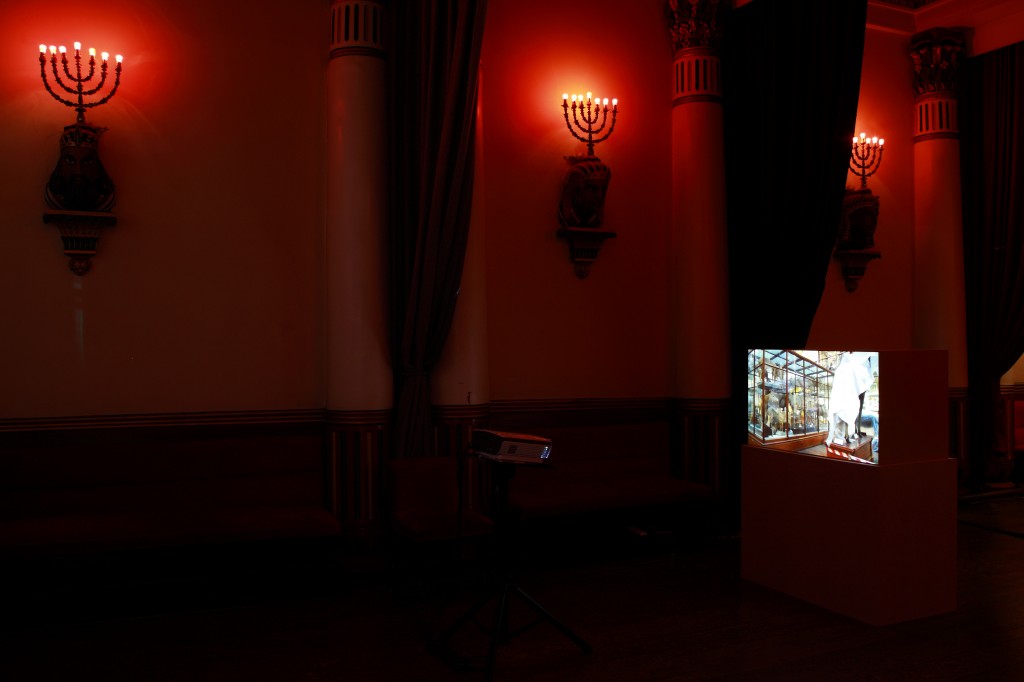
Colin Martin: Vitrine (2012)
HD video
Image courtesy the artist.
At first glance Owen Boss’ work jars with that of O’Dea’s and / or Martin’s. It didn’t immediately push the same emotive buttons. The overtone of his two videos Anything for a quiet life and Testimonial is far more matter-of-fact than subliminal. In both works Boss uses existing footage as the starting point, which is then edited in a staccato-style – sharp and witty, yet jolting and disruptive at the same time. There is no space here for contemplation or indirectness; instead we are consumed by hasty narration and quick-paced images. Having put these first impressions aside, the links contextualising his practice with that of his colleagues started to emerge, since he, too, investigates the complexity of representation, even if how he approaches it is less ceremonious. In Testimonial, Boss replaces the original voices of Brian Clough and Don Revie (two football managers of English clubs in the 1970s) with voice-overs from a British movie The Damned United, and vice versa, and as the scenes unravel the incompatibility of mouth movements and voices becomes more and more disturbing. The dubbing motif reoccurs in another context in Anything for a quiet life, which recalls the career of the actor Jack Hawkins, who continued to act after losing his voice to throat cancer, but had his speaking parts dubbed over by other actors. Here, abruptly edited frames from his movies are juxtaposed with extracts from his autobiography and the medical diagnosis of his illness. Boss’ application of the dubbing motif in two different iterations injects an extra layer of complexity into the inquiry of the parameters of representation and reality. Toying with perceived divisions between what is real and what is a manufactured substitute, he ‘calls into question the original occurrence’.

Owen Boss: Anything For A Quiet Life, 2012
installation shot, HD video
Image courtesy the artist.
Any decision to stage an art exhibition outside the white cube scenario carries the inherent risk of allowing a charged space dominate the narrative of the show itself. This, I imagine, must always be of particular concern to artists or curators who embark on such a journey. It can particularly be the case, when the challenges posed by the venue are not solely architectural but rather of ideological nature.
The latter aspect calls for a wide-angled and multi-directional viewpoint that transforms the potential negatives of a charged space into the show’s advantage, thus bringing the focus back to the artwork itself while at the same time, avoiding loading the artwork with unwanted context or, at worst, suffocating its potential meaning.
Marysia Wieckiewicz-Carroll is currently based in Dublin. A recent graduate of the MA Art in the Contemporary World at NCAD, she has been involved in a number of exhibitions and projects in Ireland. She has organised the sound/performance/radio event Sound+/-Vision that will take place at the Joinery later this month.
___
[1] All quotations are from the press release, unless stated otherwise.

